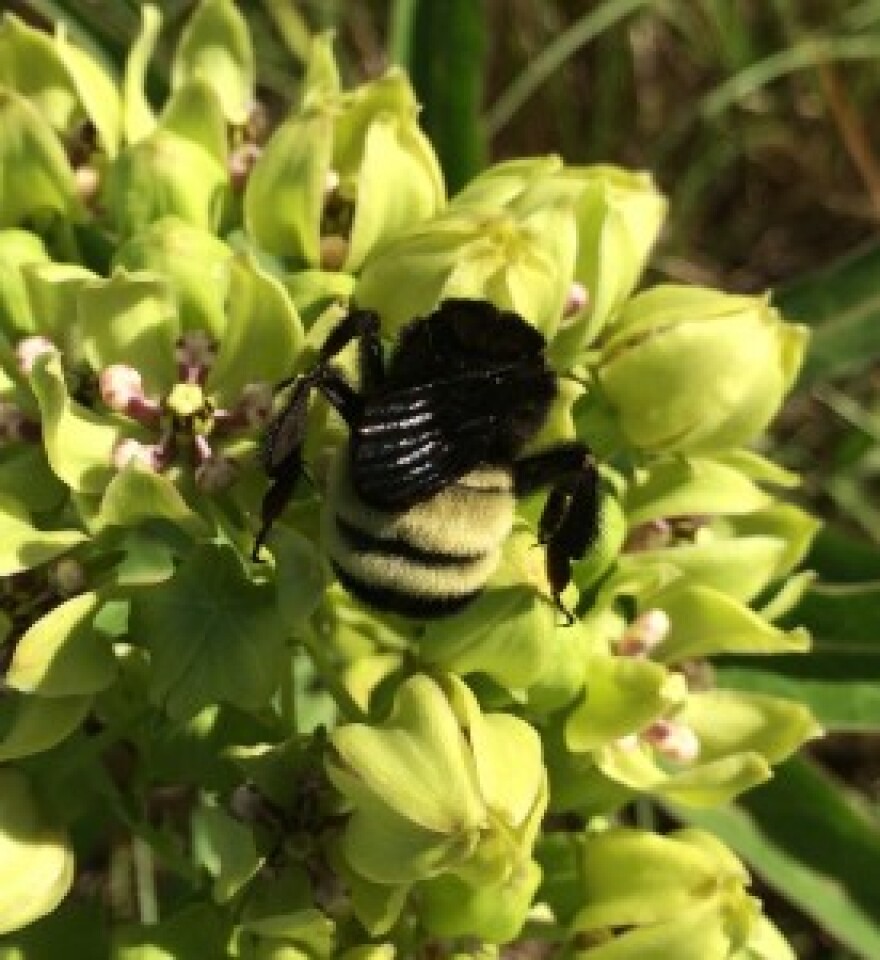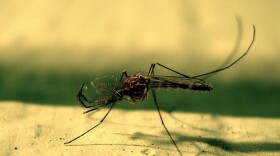If you like chili peppers, tomatoes or blueberries, you like bumblebees. The larger, hairier cousin of the honey bee is a social insect, and especially good at pollinating the tasty crops mentioned above. What’s concerning is that bumblebees are on the decline, and the Texas Parks and Wildlife Department has designated the American bumblebee as a “species of greatest conservation need.”
Jessica Beckham is outfitted in blue jeans and a button up red plaid shirt. She doesn’t look like a bee mutilator. But she used to come to this community park to cut the toes off of bumblebees.
“The bees go in the cooler,” she says, “And when they’re asleep, I literally use a pair of mustache scissors to cut a toe off their middle leg.”
OK, Beckham says the thing at the end of a bee leg isn’t actually called a toe, it’s officially known as the terminal tarsal segment. In any case, that’s how she gets bee DNA for her research as a graduate student at the University of North Texas.

“The good news is we don’t have to kill the bees in order to get those samples,” Beckham says. “We just warm them back up and they fly away.”
The Bee Decline
Today we’re foraging for bees at Shiloh Field in Denton. Spanning more than 14 acres, it’s the largest community garden in the U.S. The plots of corn, carrots and green beans help feed people here, and, it turns out, bees.
Swarming above the white petals on the blackberry bushes are honey bees.
“[Honey bees] are relatively small,” Beckham says. “A bumble bee is twice the size and a lot fatter.”
Both honey bees and their larger, hairier cousins have had a very tough decade. In late 2006, American beekeepers began reporting large-scale colony losses of honey bees, an average of 30 percent or more of overwintering hives.
Bee populations in the wild are harder to track, but in the last century there’s been a steady decline of bumble bee species in the northeastern U.S. The Texas Parks and Wildlife Department has designated the American bumblebee as a “species of greatest conservation need.”
“One of the major reasons bumblebees are declining is because of habitat loss due to human activity,” Beckham says.

Although honey bees have been in the headlines because they’re raised and carted around from farm to farm, wild bumblebees are actually more efficient pollinators, and help plants honey bees can’t access.
Bumble Bee Conservation In Texas
Beckham has hunted down bumblebees at parks and gardens in North Texas to document which species are still around, and establish a baseline to measure population growth — or decline — in the future. And the good news, she says, in community gardens she consistently found two species of bumble bees: the American and the Southern Plains bumble bee.
Both are yellow and black, but the American bumblebee has a longer tongue than the Southern Plains bumblebee. It’s a matter of millimeters, but every bit helps when you’re trying to reach nectar in a flower.
Bechkam’s research showed that community gardens can serve as small island habitats for bees — a refuge in a city unfriendly to insects. She’s now using the data to target areas across Texas for bumblebee conservation.
One of her ideas is to use roadside spaces more efficiently. In roadside surveys Beckhyam found that areas with longer grass had more bumblebees. Something as simple as doing extra planting or changing mowing practices, she says, could help.

One challenge unique to Texas is that more than95 percent of the land is privately owned, so conservation efforts will most likely have to be public-private partnerships.
For those of us who don’t own large swaths of land, Beckham says supporting bumblebees is as simple as planting flowers. Sunflowers and milkweed are two bumblebee favorites.
Here’s a list of five easy — and beautiful — plants you can put in your garden that bees will also enjoy:
- Sunflowers
- Viper’s bugloss
- Lavender
- Strawberries
- Swamp Milkweed





